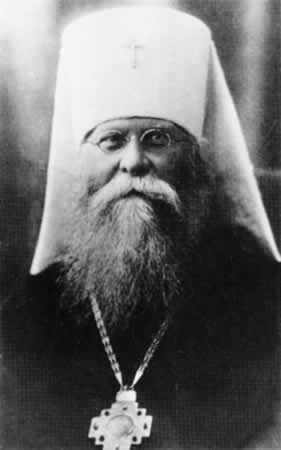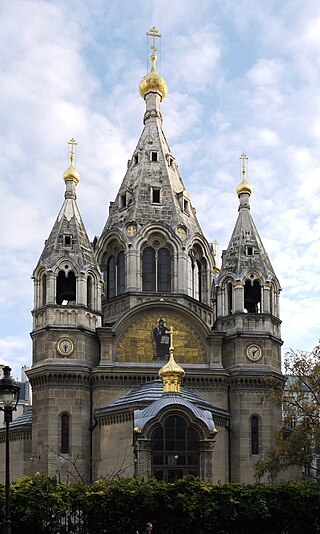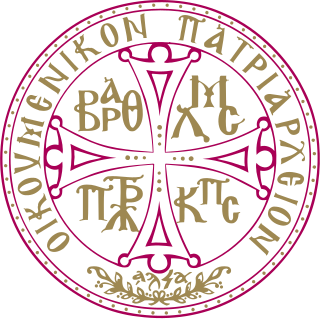Related Research Articles

The Russian Orthodox Church, alternatively legally known as the Moscow Patriarchate, is an autocephalous Eastern Orthodox Christian church. It has 194 dioceses inside Russia. The primate of the ROC is the Patriarch of Moscow and all Rus'. The Russian Orthodox Church is not fully part of the Orthodox Communion since it is currently in a schism with other Orthodox churches, such as the Ecumenical Patriarchate of Constantinople, the Patriarchate of Alexandria and all Africa, the Church of Greece and the Church of Cyprus.

Patriarch Alexy II was the 15th Patriarch of Moscow and all Rus', the primate of the Russian Orthodox Church.
Renovationism – also called Renovated Church or by metonymy the Living Church –, officially named Orthodox Russian Church, and later Orthodox Church in USSR, was a religious movement that schismed from the Russian Orthodox Church in 1922. The movement ceased to exist in late 1940s.

The Russian Orthodox Diocese of Sourozh is a diocese of the Russian Orthodox Church (ROC), covering the islands of Great Britain and Ireland. Since 28 December 2018, the Diocese of Sourozh is part of the Patriarchal Exarchate in Western Europe.

Patriarch Filaret is a Ukrainian religious leader, currently serving as the primate and Patriarch of the unrecognized Ukrainian Orthodox Church – Kyiv Patriarchate. The Orthodox Church of Ukraine, that he left in 2019, views him as the Honorary Patriarch emeritus, while the Ecumenical Patriarchate of Constantinople recognises him as former Metropolitan of Kyiv. He was formerly the Metropolitan of Kiev and the Exarch of Ukraine in the Patriarchate of Moscow (1966–1992). After joining the Kyiv Patriarchate, he was defrocked and in 1997 excommunicated by the ROC.

The Russian Orthodox Church Outside of Russia, also called Russian Orthodox Church Outside Russia or ROCOR, or Russian Orthodox Church Abroad (ROCA), is a semi-autonomous part of the Russian Orthodox Church. Currently, the position of First-Hierarch of the ROCOR is occupied by Metropolitan Nicholas (Olhovsky).

Patriarch Pimen, was the 14th Patriarch of Moscow and the head of the Russian Orthodox Church from 1970 to 1990.

Patriarch Alexy I was the 13th Patriarch of Moscow and all Rus', Primate of the Russian Orthodox Church (ROC) between 1945 and 1970.

Patriarch Sergius was the 12th Patriarch of Moscow and all the Rus', from September 8, 1943 until his death on May 15, 1944. He was also the de facto head of the Russian Orthodox Church in 1925–1943, firstly as deputy Patriarchal locum tenens (1925–1937) subsequently as Patriarchal locum tenens (1937–1943).
The Catacomb Church as a collective name labels those representatives of the Russian Orthodox clergy, laity, communities, monasteries, brotherhoods, etc., who for various reasons, have moved to an illegal position since the 1920s. In a narrow sense, the term "catacomb church" means not just illegal communities, but communities that rejected subordination to the Acting patriarchal locum tenens Metropolitan Sergius (Stragorodsky) after 1927, and adopted anti-Soviet positions. During the Cold War the ROCOR popularized the term in the latter sense, first within the Russian diaspora, and then in the USSR by sending illegal literature there. The expression "True Orthodox church" is synonym for this latter, narrower sense of "catacomb church".

Metropolitan Joseph was a bishop of the Russian Orthodox Church, metropolitan of Petrograd (1926-1927). Master of Divinity (1903) and spiritual writer. He refused to accept the Declaration of 1927 on full loyalty to the soviet authorities and his transfer to the Diocese of Odessa, he became the leader of Josephite movement. He died during the Great Purge.

The Archdiocese of Russian Orthodox Churches in Western Europe, also called Archdiocese of Parishes of the Russian Tradition in Western Europe, is a Paris-headquartered diocese consisting of parishes in Russian orthodox tradition, located in Western Europe. The diocese hails from the Provisional Administration of Russian Parishes in Western Europe, created in 1921.

Metropolitan Anthony was a bishop of the Russian Orthodox Church in the Russian Empire, the Metropolitan of Kiev and Galicia, who after the defeat of Gen Pyotr Wrangel′s White Army in South Russia in November 1920 emigrated and in 1921 settled down in Sremski Karlovci, Serbia. He, along with several other Russian bishops in exile, established an independent Russian church administration that sought to embrace all Russian Orthodox diaspora, known as the Russian Orthodox Church Outside Russia (ROCOR).

The Patriarch of Moscow and all Rus', also known as the Patriarch of Moscow and all Russia, is the title of the primate of the Russian Orthodox Church. It is often preceded by the honorific "His Holiness". As the ordinary of the Diocese of Moscow, the office holder's direct canonical remit extends only to Moscow; however, as Patriarch, the office holder has a number of church-wide administrative powers as laid down by the charter of the Russian Orthodox Church.
The Bishops' Council of the Russian Orthodox Church is a local Council, which involves only the bishops, is a formal gathering or council of bishops together with other clerical and lay delegates representing the church to deal with matters of faith, morality, rite, and canonical and cultural life. The supreme body of the hierarchical control of the Russian Orthodox Church, as well as the highest authority in the management of the Ukrainian Orthodox Church.
The 1990 Local Council meeting was the fifth in the history of the Russian Orthodox Church, the Local Council in the second patriarchal period, which took place on 7 and 8 June 1990 at the Trinity Lavra of St. Sergius.

A schism between the Russian Orthodox Church and the Ecumenical Patriarchate of Constantinople began on 15 October 2018 when the former unilaterally severed full communion with the latter.

In 1996 a schism between Moscow and Constantinople occurred; this schism began on 23 February 1996, when the Russian Orthodox Church severed full communion with the Ecumenical Patriarchate of Constantinople, and ended on 16 May 1996 when the Russian Orthodox Church and the Ecumenical Patriarchate reached an agreement.

The Diocese of the Philippines and Vietnam is a diocese of the Patriarchate of Moscow created on 26 February 2019, directly under the Patriarchal Exarchate in Southeast Asia (PESEA).

The joining of the Archdiocese of Russian Orthodox churches in Western Europe to the Moscow Patriarchate was the process of the Archdiocese of Russian Orthodox churches in Western Europe (AROCWE), formerly part of the Patriarchate of Constantinople, entering the jurisdiction of the Moscow Patriarchate.
References
- ↑ "ДЕЯНИЕ ОСВЯЩЕННОГО ПОМЕСТНОГО СОБОРА РУССКОЙ ПРАВОСЛАВНОЙ ЦЕРКВИ ОБ ОТМЕНЕ КЛЯТВ НА СТАРЫЕ ОБРЯДЫ И НА ПРИДЕРЖИВАЮЩИХСЯ ИХ". Archived from the original on 2014-03-24. Retrieved 2013-12-27.